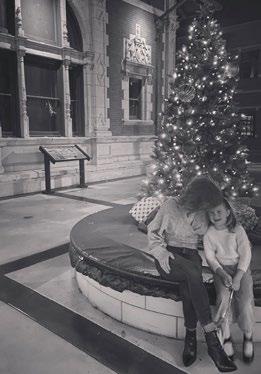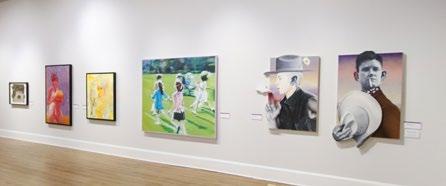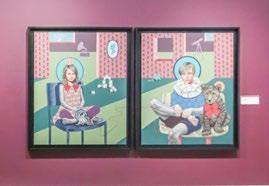

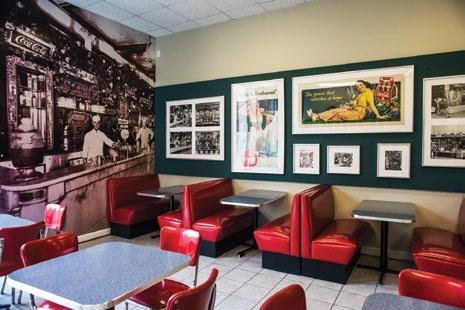
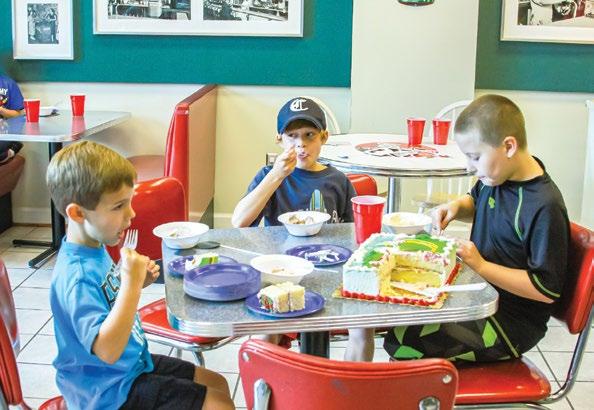









MANAGING EDITOR
Becky Wood
MARKETING
DESIGN MANAGERYvette Campagna
MARKETING COMMUNICATIONS MANAGER
Maegan Collins
Larry Richardson
Ron Smithfield
Kate Tallman
Anna Woten
Kathryn Ely
The mission of this publication is to foster creativity and champion our area’s unique cultural diversity. SECOND & COMMERCE expands the Customs House Museum & Cultural Center’s purpose through supporting the arts community, exploring local history and telling stories about the past, present and future of Clarksville.
Lott EXECUTIVE DIRECTORI recently re-read my friend John O’Brien’s book A History of Fort Campbell, along with his insightful article in the January issue of Second & Commerce about the establishment of Camp Campbell in 1942. I feel compelled to share a thought on this unique relationship between our city of Clarksville and the city of Fort Campbell –what John refers to as a “world-class Army home.”
John’s final chapter, titled “Civitas” (Latin for “the city”), quotes the Greek philosopher Aristotle, who wrote in 350 B.C., “When several villages are united in a single, complete community, large enough to be nearly or quite self-sufficing, the city comes into existence, originating in the bare needs of life, and continuing in existence for the sake of the good life.”
There is a parallel to be drawn between John’s history of Fort Campbell and our newly opened children’s exhibit, Exploring Our Town: An Adventure for All Ages, which delves into how and why a town is formed. There is no guarantee that growth and viability will be sustained. One can speculate that the cities of Clarksville and Fort Campbell both happened somewhat by accident, yet each has flourished because of the other. We are fortunate indeed that we have a “city within our city” that stirs in us both patriotic pride and a shared appreciation for the military families living among us.
John’s final sentence reads “Along the way, if we seek to remain a worldclass Army home, we should remember Aristotle’s injunction about the nature of the civitas once it comes into being: the nature of the city is not just that men live, but that men live well.” I feel the same applies to us who live outside the gates of Fort Campbell. It is worth your time to explore and learn more about your city.
Enjoy this issue of Second & Commerce.
Jamie Durrett, Chair
Thomasa Ross, Vice Chair
Paige Adkins
Frazier Allen
Dan Black
Kell Black
Joe Creek* Jim Diehr
Darwin Eldridge
Morgan Knight*
Lawson Mabry
Linda Nichols
Brendalyn Player
Larry Richardson

Vondell Richmond* Wes Sumner Eleanor Williams*
*denotes ex-officio

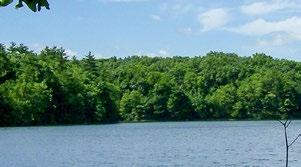
In the words of Henry David Thoreau: “The question is not what you look at, but what you see.” More than 150 years later, Thoreau’s journals have become a source of both philosophical resonance and scientific discovery. This spotlight on our Museum collections explores how the pieces in our archives tell the story of our changing environment.
Lieutenant Colonel Frank Adkins was the most decorated Montgomery County resident to have served in World War II. The discovery of some of his belongings in a long-forgotten box brought the story of this hometown hero into the 21st century, and sent the Adkins family on a journey of reconnection.


A recent acquisition of artifacts from local drag performer Amanda Leigh inspired the Customs House Museum & Cultural Center’s Clarksville LGBTQIA+ History Initiative, which aims to bolster the institution’s ability to approach more diverse histories. Curator of Collections Anna Woten expounds upon why collecting these stories is so important.
Jack Bastin has been a vendor in Seasons: The Museum Store for more than a decade, offering hand-crafted wooden bowls, rolling pins, tree ornaments, biscuit cutters and more. Take a special look inside his Clarksville workshop and see how these timber creations come to life.

Federal Duck Stamps are miniature works of art prized by stamp collectors around the world. These stamps are a source of conservation revenue for the National Wildlife Refuge System, with artwork determined by an annual juried competition. In 2021, local artist Larry Richardson had the once-in-a-lifetime honor of judging this contest.

New Memories, New Adventures, New Explorers Landing! The revamped exhibit Exploring Our Town: An Adventure for All Ages is now open at the Museum. See the step-by-step process of how this exhibit evolved over nearly two years, from the spark of an idea to the grand reopening.

DAC & FRIENDS
Downtown Artists Co-op April 1 – May 1
INDOOR COMMUNITY FLEA MARKET
Burt-Cobb Recreation Center Saturday, April 2 | 8am-1pm
READY, SET, KNOW: A CHILDREN’S HEALTH FAIR
Customs House Museum & Cultural Center Saturday, April 2 | 1-4pm
54TH ANNUAL JURIED STUDENT EXHIBITION
The New Gallery, Austin Peay State University April 4 – April 27
FIRST THURSDAY ART WALK
Downtown Clarksville Thursday, April 7 | 5-8pm
APSU THEATRE AND DANCE PRESENTS: THE SPRING DANCE CONCERT
Trahern Theatre, Austin Peay State University Thursday, April 7 | 7:30pm Friday, April 8 | 7:30pm Saturday, April 9 | 2pm & 7:30pm Sunday, April 10 | 2pm

Mabry Concert Hall, Austin Peay State University Saturday, April 9 | 7:30pm
CECA VISITING ARTIST SPEAKER SERIES: JORDAN KOCH
Art + Design Building, Austin Peay State University Tuesday, April 12 | 6pm
GATEWAY CHAMBER ORCHESTRA PRESENTS: MAHLER'S RESURRECTION
Mabry Concert Hall, Austin Peay State University Saturday, April 23 | 7:30pm Sunday, April 24 | 4pm
SHAKESPEARE IN THE PARK
Wilma Rudolph Event Center Ampitheater Saturday, April 30 | 5:30pm
SPRING CRAFTSMEN'S FAIR
Old Glory Distilling Co. Saturday, April 30 & Sunday, May 1 MAY
LA GRAN PAYBACK
Customs House Museum & Cultural Center Wednesday, May 4 | 5:30pm
FIRST THURSDAY ART WALK
CIVIL WAR ARTIFACTS DISPLAY
Fort Defiance Civil War Park & Interpretive Center Saturday, April 9 | 10am-3pm
Downtown Clarksville Thursday,

Roxy Regional Theatre
Wednesday, May 18 | 7pm
Art + Design Building, Austin Peay State University
Thursday, May 19 & Friday, May 20

Liberty Park Saturday, May 28
Downtown Clarksville
Thursday, June 2 | 5-8pm

Downtown Artists Co-op
June 2 – June 26

Customs House Museum & Cultural Center Saturday, June 11 | 6-9pm
Heritage Park Saturday, June 11

A Fundraiser for the Customs House Museum & Cultural Center
Oak Grove Racing, Gaming & Hotel Saturday, July 16 | 5pm

Ned Crouch first arrived in Clarksville in 1967 “in a Volkswagen Bug packed with a stereo and some art books.” In the decades that followed, he and his wife Jacqueline wove themselves through Tennessee’s arts community, at the Customs House Museum & Cultural Center and beyond.


Ned was born into an artistic family, and trained as a sculptor at Austin Peay State University under Olen Bryant and at the Cranbrook Academy of Art in Michigan. He went on to establish a career as an artist, preservationist and curator, while Jacqueline taught art in the Clarksville-Montgomery County School System.

Growing up, Ned’s father was the director of The Children's Museum of Nashville, which is now the Adventure Science Center. As longtime collectors of outsider and folk art and allies of local artists, the Crouches were early supporters of the Museum.
Ned joined the Museum Board of Trustees in 1987, serving two terms before taking over as interim executive director when Bob Patterson left in 1998. "It was Bob who told Ned that he was the one person on the Board with the connection and understanding for this job,” explained Jacqueline. “He said it would only be two or three months...”
Those few months grew into nearly ten years, and Ned served as the Museum’s director until 2007. “It grew around me, and I grew around it,” said Ned. “It was like Mickey Rooney putting on a show – we'd sit in my office and scheme up exhibits and other projects.”
Ned guided the Museum through many of its most significant defining moments, like the 1999 tornado. When he got the phone call about the storm on that January night, he immediately went downtown to assess the damage.
“We lost all the air conditioners on the roof, the cupola was damaged,” said Ned. “Everything else around the Museum was leveled.” With all the windows blown out, the Museum was in a vulnerable state. There were numerous exhibits on display at the time, including a large collection of Dr. Benjamin Caldwell's presidential silver. Ned slept at the Museum on a cot with a sidearm and a flashlight, guarding the building for a week.
ABOVE: The Crouches’ extensive art collection fills their eclectic Glenwood home, complete with works by local artists like Olen Bryant. LEFT: Ned and Jacqueline have dedicated their lives to the collection, preservation and exhibition of folk and outsider art.From the beginnings of the Boehm porcelain collection to some of the Museum’s biggest blockbuster exhibits, the Crouches were central to the organization’s growth. The still-buzzed-about exhibit Reelfoot Lake: Tradition, Mystery & Lore was a massive undertaking that also included a commemorative magazine and the Museum’s first film.
“Every weekend, we drove to Reelfoot and stayed on the banks of the lake,” said Ned. Jacqueline, who assisted with various Museum projects during her summer breaks from teaching, played a major role in developing the Reelfoot exhibit. What started as an idea for a small show quickly grew into one of the Museum’s biggest, thanks to a trip to the local library.
“I found just one book – but in that book, I realized there were all these other stories,” said Jacqueline. “I told Ned, ‘There are layers to this place that you might want to explore.’” She spent her summer vacation in Exhibits Curator Terri Jordan’s office, doing research and making phone calls. That exhibit brought about 600 people into the
Museum for its opening reception, complete with Reelfoot eagles and hunting dogs.

There is not enough room in this particular text to fully explore Ned and Jacqueline Crouch's impact on the arts in this area. One could go on for pages about the couple’s extensive personal collection of folk art, or Ned’s dedication to
preserving and restoring the works of E.T. Wickham. In the midst of all their artistic and philanthropic endeavors, their influence on the Customs House Museum & Cultural Center is clear.
In 1992, Ned stood in what is now the Museum’s courtyard with Bob Patterson, Frank Lott and Gene Washer, and the four of them dreamed up a plan to expand the Museum. They traveled to Nashville to meet with Riley Darnell, Tennessee Secretary of State under Governor Ned McWherter. After a pitch in the middle of Swett’s Restaurant on Clifton Avenue, they came back with a commitment of a million dollars. In addition to being loyal members, Ned and Jacqueline have been a key part of developing the Museum into what it is today.
Become a member today! customshousemuseum.org/ become-a-member
The 2005 exhibit Reelfoot Lake: Tradition, Mystery & Lore is still talked about today by long-time Museum members and staff, along with its corresponding magazine and documentary film.
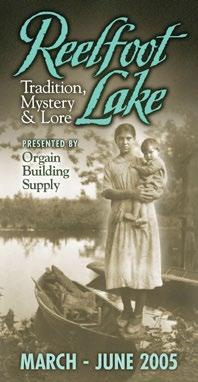
Max Hochstetler and Ned Crouch both joined Austin Peay State University’s art department in 1967 – Max as a young professor, and Ned as an enthusiastic undergraduate. Max taught at Austin Peay for 32 years, serving as chair of the department from 1989 to 1993, and was awarded emeritus status in 1999. Ned credits APSU professors like Max, Olen Bryant and Charles Young as key guides to his growth as a student, and many of those teachers grew from mentors to friends.
When Ned and Jacqueline married in 1969, Max gifted them Man with Rooster, an oil on Masonite piece that he painted two years prior. The Crouches have donated over 60 works of art to the Customs House Museum & Cultural Center’s collection over the years, and this piece joined the list in 2020. Man with Rooster now welcomes visitors to the Museum with a prominent display in our courtyard.
Look out for a feature all about Max Hochstetler in a future issue of Second & Commerce.
As longtime collectors of outsider and folk art and allies of local artists, the Crouches were early supporters of the Museum.Jacqueline Crouch poses with the Man with Rooster banner in the Museum courtyard.
 BY KATE TALLMAN, COLLECTIONS ASSOCIATE
BY KATE TALLMAN, COLLECTIONS ASSOCIATE
“The earth was filled with warm rain; the streams were swollen with excessive drainage; yet the clouds covered the sky and the grey mistiness only changed when heavy rains limited the visibility. The sun was powerless to penetrate the mist.”
him. In 1845, he moved to a remote cabin on Walden Pond in Massachusetts and lived alone for two years, retreating from the demands of modern life and immersing himself in the New England wilderness. He started journaling about the flora and fauna around him in 1837 in appreciation of his surroundings, but the detailed records of his daily walks would continue until his death, spanning 25 years of seasonal changes.
His descriptions recorded the flowering dates of 500 species of plants, flowers and shrubs, and unintentionally created records that biologists would pore over a century and a half later.
Scientists from Boston University found that almost half of the wildflowers Thoreau eagerly anticipated each Massachusetts spring no longer, or rarely, bloomed in the region. Urban development, pollution and the shifting patterns of wildlife are all attributed as the cause, but the fundamental role that a lived human experience played in this scientific discovery is key.
In Clarksville, the Customs House Museum & Cultural Center is the custodian of many of our shared histories. While we do not have scientific collections, our historical collections tell the stories of people living through similar environmental shifts. Clarksville has endured annual flooding events due to its location in the Cumberland River floodplain. The most destructive floods occurred during the winters of 1926-1927 and 1936-1937, in 1975, 1997 and 2010. These events caused millions of dollars in damage and hundreds of deaths, reshaping Montgomery County – all within the lifetime of an average American.
The Museum archives contain a dramatic illustration of this history in photos of trains struggling to carry goods during the worst of it. The flood of 1927 saw the Cumberland River swell to three miles across at its widest point, homes submerged and bridges washed away. It was the worst flood in recorded history, until a decade later when it was surpassed by more than five feet.
After three weeks of steady rainfall, homes and businesses were engulfed, the Clarksville Waterworks had to shut down and the city could no longer supply drinking water to its citizens. Emergency aid, provided by military personnel, faculty at Austin Peay and locals, struggled to provide shelter, clothing and potable water to those affected. The difference in water levels can be seen in photos taken of the old


Waterworks building. While taken from different angles, the water in relation to the windows on the right side of the building is markedly higher in 1937.
Thoreau’s journal is an idyllic example of citizen recordkeeping in a region that has seen marked environmental changes in recent years. Middle Tennessee has not yet experienced the same shifts, but we have evidence of
Our historical collections tell the stories of people living through similar environmental shifts.The old Clarksville Waterworks building during the flood of 1927 Archives Collection, Customs House Museum & Cultural Center Citizens float by the Waterworks in a canoe, 1937 Archives Collection, Customs House Museum & Cultural Center
changing weather conditions molding the current environment. The Port Royal Bridge in Montgomery County was originally built prior to the Civil War and bore witness to many historic events in the area. Most of the buildings in Port Royal were built by the labor of enslaved men and women, with the profits from the tobacco industry and commercial trade. While the exact year of its construction is unknown, the bridge was built during the town’s economic peak, serving as a reliable land route between Nashville and Hopkinsville and creating the economic stability for the founding of our city. It stood during the emancipation of the enslaved people who had built the city’s structures, and through one of the earliest recorded August 8th
Emancipation Day celebrations in Clarksville. In 1866, the bridge was swept away by a flood and rebuilt.
Port Royal endured post-Civil War economic downturn and a regional depression, caused by new railways which subverted the usefulness of the Red River route and signaled a new era of industrialization. The covered version of the bridge was built in 1904 and lasted
TOP: A Pan American train on the L&N line, December 1926
Archives Collection, Customs House Museum & Cultural Center
MIDDLE: A Mineral Branch Railroad train struggles through flooding, 1937

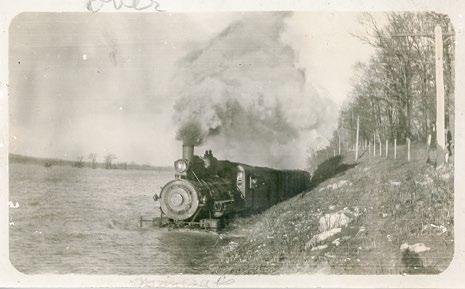
Archives Collection, Customs House Museum & Cultural Center
BOTTOM: Postcard featuring the Port Royal Covered Bridge, 1965
Archives Collection, Customs House Museum & Cultural Center

Thoreau’s journal is an idyllic example of citizen recordkeeping in a region that has seen marked environmental changes in recent years.
Pediatric
Nonprofit
well
until the 1970s, when it was again washed away in a flood. The final reincarnation was destroyed by yet another flood in 1998 and was not repaired. The stone piers are all that remain of this piece of Montgomery County history.

When Henry David Thoreau began journaling his observations about the world around him, it was not in the pursuit of scientific knowledge. Rather, it was driven by intense appreciation for the natural world and a focused understanding of the unique beauty his part of the world held. These very human experiences wrote Walden, and it is these same kind of experiences that led to the photographs and postcards in our archives.
As Earth Day approaches this April, try observing your days through this lens. How is your world shifting? How are you shaping, or being shaped by, your surroundings? History leaves no person untouched, and we are all recordkeepers of our collective story. Nothing embodies this more than the quote that began this story, which was not written by Thoreau, but by Montgomery County Historian Eleanor Williams about the flood of 1937. The beauty of the Museum’s historical collections lies in the kaleidoscope of experiences told within each individual piece, and how each of these experiences create the record of Clarksville.
walden.org
customshousemuseum.org/collections/explore-the-collections/
Topiary artist.

important to
your life
WELL PLANNED.

How did a discovery in a cluttered attic result in connections between the Customs House Museum & Cultural Center, Greenwood Cemetery, the Montgomery County Archives and far-flung cousins?
After the death of Ann Adkins’ mother Irene in 2016, she moved back to Clarksville and started cleaning out the family home on Dotsonville Road. Among years of forgotten clothes, scrapbooks and numerous other possessions, she found one very special box that changed her life and renewed longdormant relationships.
What was in that big box? A collection of artifacts belonging to Lieutenant Colonel Frank Edward Adkins, the most decorated Montgomery County resident to have served in World War II. The discovery brought together a number of Frank’s surviving relatives, myself included. The Adkins Cousins had long been scattered across different states, but Frank’s legacy has been a catalyst to renew these distant family relationships and to honor his heroic service to our country.
"I was fortunate to have found the box of Uncle Frank's documents and memorabilia, which I had no idea existed,” explained Ann. “The Adkins Cousins met and the consensus was to donate the items to the Museum and the Archives.”
At about the same time, LTC Adkins was chosen by Greenwood Cemetery’s Veterans Memorial Committee to represent all veterans with a plaque in the Veterans Garden. For years, Greenwood Cemetery Secretary-Treasurer Paul Schaaf wanted to identify one decorated veteran to act as a symbol for all who have served.

ABOVE:
Archives
RIGHT:
Museum
Frank Adkins was born and raised in Montgomery County. From an early age, his mother said he dreamed of flying. He was an all-American boy who played baseball and football at Clarksville High School, where he graduated in 1934. He attended Austin Peay Normal School as an Air Cadet and trained under Flight Instructor Frank Knapp and Colonel John Outlaw, namesake of Outlaw Field at the Clarksville Regional Airport.

Frank volunteered for the Army Air Corps in November 1940 and trained as a fighter pilot at Kelly Field in Texas. Immediately after the Pearl Harbor attack on December 7, 1941, Frank flew the defense of the west coast to protect against an expected Japanese attack. Only 10 days after Pearl Harbor, Frank was shipped out to the South Pacific. Out of 55 pilots shipped, Frank was one of fewer than half who survived the first year of the war. His first combat action was in defending the Dutch island of Java. While strafing the Japanese troops landing on the Java
coast, he was shot down, bailed out behind Japanese lines, used a native bicycle and escaped to safety with three very close calls. For this and other heroic actions, Frank was awarded the Distinguished Service Cross by General Douglas MacArthur, the nation’s second highest honor. While seeing combat in New Guinea, where he shot down three enemy Zeros, Frank was also awarded the Silver Star and Distinguished Flying Cross.
Frank was welcomed as a hometown hero with a parade in Downtown Clarksville on November 2, 1942, with thousands
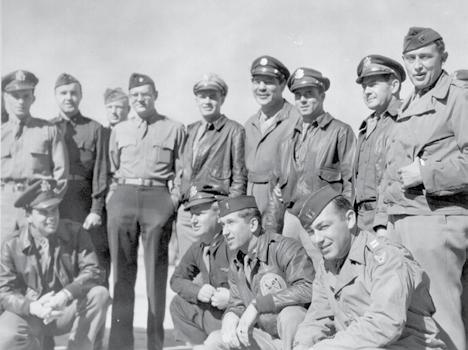

Frank’s legacy has been a catalyst to renew these distant family relationships and to honor his heroic service to our country.TOP: Posters like this one welcomed LTC Adkins back to Clarksville in November 1942. Archives Collection, Customs House Museum & Cultural Center BOTTOM: LTC Frank Adkins (third from right) with other U.S. Army Officers, ca. 1942. Archives Collection, Customs House Museum & Cultural Center
in attendance. He spoke to the huge crowd from atop the Capitol Theater marquee on Franklin Street and gave credit to “Others that were there. I was lucky.”
Shortly after the D-Day invasion, Frank shot down two German ME109s to achieve Ace Pilot status.
On July 30, 1944, Frank was leading a squadron of P-47s when, out of ammunition, he scattered a flight of German planes to protect a fellow pilot, for which he was awarded his second Distinguished Flying Cross for extraordinary courage. He also received a total of 15 Air Medals during his flying career.
Tragically, on February 23, 1945, he was killed in a training accident while flying a P-38 at high altitude and crashed near Freeport, Texas. LTC Frank Adkins was laid to rest in Greenwood Cemetery on March 3, 1945, in one of the largest funerals in Clarksville’s history, with reportedly about 3,000 people in attendance or on the route. It was a very sad day for his family and all of Clarksville to lose their hometown hero.
Frank’s nephew, Dean Matthews, grew up hearing of Frank’s service
and heroism. He later joined the Navy and became a Navy SEAL. Dean served our country for over 30 years, including two tours in Vietnam.
“As one of the last surviving relatives who physically met my uncle LTC Frank Adkins, I have vivid memories of his heroic endeavors as told by my
adding to the collection with a few pictures and a dollar bill found in Frank’s billfold when he crashed.
“My mother often spoke of Frank's good looks, valor and bravery. I don't believe that she ever fully recovered from his early death,” said Shelley. “My mother passed away this past September, just two months shy of turning 100. ‘Legacy’ now means more to me than ever, and I am proud that LTC Adkins is a part of mine.”
mother Barbara and other relatives,” said Dean. “He was known as the family hero, as well as Clarksville’s hero, of World War II.”
Frank’s last surviving sister, Margaret Adkins Keheley, died last year at age 99 in South Carolina. Two of her daughters, Shelley Keheley Baluch and Paula Keheley, traveled to Clarksville to view the Museum’s artifacts,
In October 2020, Greenwood Cemetery dedicated a memorial to LTC Adkins, and all the veterans he continues to represent. The Adkins Cousins raised funds to place a large tablet on Frank’s grave to tell the story of his service in World War II for future generations. Thanks to the discovery in her mother’s attic, Ann Adkins was inspired to volunteer at the Montgomery County Archives to help preserve local records.
“The best outcome was uniting and reconnecting our cousin relationship,” said Ann. "We share memories and stories of growing up, as well as appreciate our wonderful common bond."
What treasures might be hiding in your attic? Those discoveries are the key to preserving our local history.
A selection of these artifacts and photographs will be available to view in the exhibit Remembering Frank Adkins, on display at the Customs House Museum & Cultural Center from April 20 to June 26.
greenwoodcemeteryinc.com mcgtn.org/archives

"‘Legacy’ now means more to me than ever, and I am proud that LTC Adkins is a part of mine."
-Shelley Keheley BaluchThe Adkins Cousins examine some of the artifacts found in Irene Adkins’ attic. From left: David Smithfield, Dean Matthews, Ron Smithfield, Ann Adkins and Frances Dozier Courtesy of the Adkins Family



April is MONTH OF THE MILITARY CHILD, emphasizing the important role military children play in the armed forces community. Celebrate with us at the Customs House Museum & Cultural Center!
Wear purple on Purple Up! For Military Kids Day on Friday, April 15. Participate in a patriotic family art program on Saturday, April 16. See the special activities available in the Museum Lobby and Family Art Studio all month long.
STARTING THIS MAY! Blue Star Museums is a collaboration between the National Endowment for the Arts, Blue Star Families, the Department of Defense and museums across America to offer free admission to active-duty military personnel and their families each summer. This year, the program runs from Armed Forces Day on May 21 through Labor Day on September 5.
customshousemuseum.org

BATSONNOLAN.COM
Clarksville, TN (931) 647-1501 | Springfield, TN (615) 382-4420
BATSONNOLAN.COM
Clarksville, TN (931) 647-1501 | Springfield, TN (615) 382-4420
BATSONNOLAN.COM
Clarksville, TN (931) 647-1501 | Springfield, TN (615) 382-4420


“The roles of museums are to exhibit from their collections; reflect societies, history, cultural behaviors, traditions and rituals; and to provide their visitors with the equal opportunity to access, understand and recognize their history, identity and cultural background. In order to meet the requirements from a diverse audience, the stories told and the objects exhibited must be selected and interpreted in a way that is all inclusive.”
– Kristiane Strætkvern Chair of the ICOM International Committee of Conservation & Conservator at the National Museum of DenmarkEarly last year, the Collections Department at the Customs House Museum & Cultural Center launched its Clarksville LGBTQIA+ History Initiative to expand the Museum’s collections and bolster the institution’s ability to approach more diverse histories. Since then, we have spoken with a number of community members and have begun to collect LGBTQIA+ related history from throughout Clarksville. This practice has been a huge step forward for the Museum in its effort to expand the communities and histories that we represent.
Our LGBTQIA+ History Collection has expanded quickly since the acquisition that started the initiative: the Amanda Leigh Collection. For those involved in, or a fan of, the drag performance scene in Clarksville, Amanda Leigh is probably a familiar name. She has performed here in Clarksville since 1980, shortly after the city’s first gay bar, Cooper’s General Store, opened its doors. Her drag career has continued across the four decades since, until her retirement show this past November at Fusion Bar & Grill. “It was in Nashville that I saw my first drag show,” Leigh recalled. “It was captivating. I knew immediately that I would love to be a drag performer. I truly had no idea that dream had even a remote chance of coming true.”



MIDDLE:
Left
BOTTOM:
 TOP: Abby Lee on stage at Cooper’s General Store, 1980
Amanda Leigh at Cooper’s General Store, 1980
Drag performers in Clarksville,
to right: Unknown, Belle Terrell, Dolly Wallace, Micie (1st Miss Gay Clarksville), Mary Sue Alice, 1980
Clarksville LGBTQIA+ History Collection, Customs House Museum & Cultural Center
TOP: Abby Lee on stage at Cooper’s General Store, 1980
Amanda Leigh at Cooper’s General Store, 1980
Drag performers in Clarksville,
to right: Unknown, Belle Terrell, Dolly Wallace, Micie (1st Miss Gay Clarksville), Mary Sue Alice, 1980
Clarksville LGBTQIA+ History Collection, Customs House Museum & Cultural Center

Lesbian: A woman whose primary sexual orientation is toward people of the same gender.
Gay: A sexual orientation toward people of the same gender.
Bisexual: A person whose primary sexual and affectional orientation is toward people of the same and other genders, or towards people regardless of their gender.
Transgender: Someone who is a gender that is not the same as the gender assigned to them at birth. Being transgender is separate from a person’s sexual orientation and gender expression, and these terms should not be conflated to include being transgender.
Queer: This can include, but is not limited to, gay, lesbian, bisexual, transgender, intersex and asexual people. This term has different meanings to different people. Some still find it offensive, while others reclaim it to encompass the broader sense of history of the gay rights movement. It can also be used as an umbrella term like LGBT, as in "the queer community."
Intersex: People who, without medical intervention, develop primary or secondary sex characteristics that do not fit “neatly” into society's definitions of male or female. Intersex people are relatively common, although society's denial of their existence has allowed very little room for intersex issues to be discussed publicly.
Asexual/Aromantic: Generally characterized by not feeling sexual and/ or romantic attraction or a desire for partnered sexuality. Asexuality is distinct from celibacy, which is the deliberate abstention from sexual activity.
+ Tons of other communities!
The Amanda Leigh Collection consists of more than 80 photographs and ephemera documenting early gay nightlife in Clarksville. The collection also contains numerous textile pieces, including some of the dresses worn in the photographs. The Museum plans to add more to this collection, including a series of oral histories further discussing the topic.

When the Museum receives a collection like this one, a number of processes are enacted to properly preserve the objects and archival materials. Photographs are individually sleeved in protective film and stored in archival boxes that protect them from light and other elements that can cause further degradation. Textiles, like the dresses in this collection, are carefully padded to prevent creases (which break down the fibers in the cloth) and placed inside preservation-grade textile boxes. Once stored, all of our collections are closely monitored within environmentally controlled spaces to protect from light, humidity and temperature instability. This care ensures that these items will last for future generations.
The preservation of these items is essential in telling a more holistic history of Clarksville that includes LGBTQIA+ citizens. These artifacts connect back to both a central location in that history, Cooper’s General Store and the broader narrative in United States history.
Cooper’s General Store opened as a private club in October 1979 on Franklin Street in Downtown Clarksville. The letters “C.G.S.” hung above the door to greet patrons and passers-by. Those letters publicly stood for “Cooper’s General Store,” but those in-the-know knew the letters stood for “Clarksville Gay Society.”
“Before Cooper’s, I only had ever known three gay people,” said Leigh. “Cooper’s opened, and I, for the first time in my life, was making friends. Not only friends, but friends who I actually had something in common with, gay friends! It was like a whole new world to me.”
Though the club was the first of its kind in Clarksville, it was a product of a broader movement in the United States and abroad. “Gay bars” have existed in various forms in the U.S. since at least the 1920s, with
a number of them operating continuously since Prohibition ended in 1933. Early gay bars served an important function for the community: they were a place for the LGBTQIA+ community to socialize and mingle at a time when it was illegal for two men to even be seen dancing together. They were also often a site for “cruising,” the act of searching for a sexual partner by walking or driving around a specific area. Gay bars in the 1960s and 70s onward were used as spaces to organize as the Gay Liberation Movement began to gain momentum after the Stonewall Riots in New York City in 1969, and dozens of other earlier riots like the Compton’s Cafeteria Riot in San Francisco in 1966 and the 1959 riot at Cooper’s Do-nuts in Los Angeles.
Leading up to these riots, police raids were a common tactic used
TOP: Ms. Gay Clarksville Winners, Left to right: Kanessa (1983-84), Amanda (1984-85), Ashley Grant (1985-86)

BOTTOM: Amanda Leigh and a patron at the Haberdashery, 1982 Clarksville LGBTQIA+ History Collection, Customs House Museum & Cultural Center


Drag is a type of entertainment where people dress up and perform in highly stylized ways. This often includes exaggerated clothing and makeup of a gender other than the performer’s and the creation of a stage persona. While some drag performers may be transgender, most are not, and the two should not be conflated.
against LGBT spaces. The 1960s, 70s and 80s saw these raids increase in frequency and scale. Patrons of these establishments would be arrested, photographed and sometimes paraded through public places and police stations. Their names and pictures would often appear in newspapers in the following days, leading to catastrophic personal, social and economic fallout. Clarksville was

no stranger to these raids, including the infamous 1981 raid at Trice Landing, a popular place for gay cruising.
Reportedly, Cooper’s General Store was also a victim of harassment during the brief period that it remained open. Even though it was a private club that operated on memberships, Cooper’s patrons reported that dozens of police officers would enter the club and harass those inside. According to former board members, it was the threat of an upcoming raid that eventually forced Cooper’s to shut its doors in 1980.
“Cooper’s definitely laid the foundation of my life,” said Leigh. “I don’t know what I would have done or who I would have been had Cooper’s never opened – but I am certain I would not be who I am today. My life has definitely not been an easy life, but I can say with complete certainty that Cooper’s General Store was the best thing to ever happen to me.”
LGBTQIA+ people have heard innumerable “arguments'' and accusations against their very existence, but one statement in particular seems to come up frequently: “That kind of thing never happened in my day.” Stories from people like Amanda Leigh and places like Cooper’s prove that the idea of LGBTQIA+ relationships and transgender people transitioning is not a new phenomenon brought on by younger generations.
This misconception is prevalent due to teacher shortages and underfunding, general lack of subject-area knowledge and legislative efforts to suppress certain historical narratives. Because of these efforts, we learn very specific histories in primary and secondary schools. As a result, many historical narratives rely on institutions like museums as “non-traditional” educational spaces.
When we learn about Cooper’s and other LGBTQIA+ histories, we realize that LGBTQIA+ people have existed


BELOW:
since long before Stonewall and the Gay Liberation Movement. Countless records of queer and transgender people have existed across cultures and histories for as long as these records have been kept. Many Pacific Island cultures traditionally celebrate genders beyond the western binary of man and woman. We also have records from early American history of people living as the “opposite” gender. While some of these occurrences were surely for safety or other socio-economic purposes, many were documented to be similar to the expression and intent of transgender people today. From 1870 to 1920, “Boston Marriages” were popular here in the United States, and involved the cohabitation and pooling of finances of a pair of women. Some of these marriages were simply financial arrangements for independence, though historical letters and journals show that many were actually romantic in nature. Colonialism has largely obscured these stories on many continents, including our own, but even recently there has been a concerted effort to erase it. In 1933, Nazi demonstrators raided the Institute of Sexology in Germany, a private research center that housed much of the “modern world’s” research on gender and sexuality. Over the course of a few days, all of the center’s medical records, research notes and approximately 20,000 books were burned. The data and research lost in this raid has never been recovered. Even now, these efforts to obscure and erase LGBTQIA+ histories continue with laws like the ones
in recent years in Tennessee, Florida, Texas, Idaho and many other states that restrict when and where the narratives can be told. The responsibility increasingly falls to institutions like museums to make sure history is properly preserved and shared.



It is this need for history to be preserved and our passion for Clarksville’s communities that has driven us to begin efforts like the Clarksville LGBTQIA+ History Initiative. With the Amanda Leigh Collection as its anchor, a broader and more diverse collection of queer and transgender history can be built and maintained to tell the stories of LGBTQIA+ Clarksville.
The Museum carries the responsibility of telling the stories of all the diverse communities that make up the foundation of Clarksville. The museum field as a whole has largely neglected this responsibility for the last few centuries, but we are committed to doing better. Many more collecting initiatives are in the works for the Customs House Museum & Cultural Center, and we are excited to continue to preserve and interpret the history of other Clarksville communities.

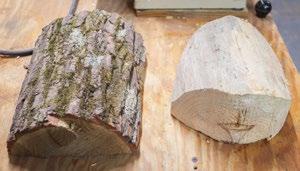


Jack Bastin hasn’t always been a woodworker.
“I think I was 72 when I started,” he recalled. “I went to a demonstration with a friend of mine, came home, bought a small lathe and started from there.” Now, at age 95, he continues to turn out works of art from his woodland workshop, crafting everything from ballpoint pens to serving bowls. One of Jack’s bowls is the culmination of hours of work over the course of days, or even weeks, depending on the wood type and other environmental factors.

Starting as a log, the piece gets chopped into a blank of the approximate dimensions for the final product. All of Jack’s lumber is sourced from trees that have already fallen, either on his own property or brought by neighbors and other members of the community.
The blank is attached to a faceplate to keep it steady on the lathe, where Jack uses a variety of gouges, scrapers and chisels to round out the bottom and hollow out the middle.
After measuring the level of moisture in the wood, he leaves the piece to dry. As the wood dries, it can warp and become out-of-round, so the bowl is put back on the lathe to be smoothed and hollowed out again. Jack is careful to keep an eye on the piece’s depth – a bowl can quickly turn into a funnel if taken too far.
He sands everything down for a final time and it’s time to add a finish. Jack uses walnut oil for a rustic finish that lets the features of the wood shine, without any extra glosses or stains.
Whether it’s a bowl, rolling pin or Christmas ornament, every piece is one of a kind. See one of Jack's beautifully crafted bowls 'al fresco' on the opposite page! A selection of Jack Bastin’s woodworks are available for purchase at Seasons: The Museum Store.



 BY LARRY RICHARDSON, MEMBERSHIP & MARKETING COMMITTEE CHAIRMAN
BY LARRY RICHARDSON, MEMBERSHIP & MARKETING COMMITTEE CHAIRMAN
I am an artist, a writer and a naturalist. The woods and creeks of Kentucky where I was raised were always calling. I love wild places and the wild things that live there, and a series of paintings of the Cumberland River continue to occupy my easel.
Wild places are often epitomized by the sound of waterfowl passing overhead. Legendary composer Richard Rogers wrote, “Wild geese that fly with moon on their wings, these are a few of my favorite things,” in a song from The Sound of Music. The sights and sounds of ducks, geese and other water birds have quickened the heartbeat and awakened the wanderlust in all of us. But the wonders of nature were threatened in the not-toodistant past during the Great Depression and Dust Bowl drought through Middle America in the 1930s.
Miraculously, conservationists and Congress came together to create a funding source by establishing a nationwide system of waterfowl refuges. Income from a newly created waterfowl hunting license, affectionately known as the “Duck Stamp,” began paying for acquisition and maintenance of land and water across the country during a perilous economic and environmental period. The National Wildlife Refuge System was born as a safe haven, not only for water birds, but for hundreds of migrating and local animal species. Conservation financing continues as the result of an annual Duck Stamp license that bears an image of a duck, swan or goose selected by an art contest.
Three blue-winged teals at Duck River Bottoms Photo by Clayton Ferrell, USFWS Refuge Biologist Courtesy of the Tennessee National Wildlife Refuge Winter at Cross Creeks National Wildlife Refuge Photo by Richard Hines, Former USFWS Refuge Manager at Cross Creeks NWR Courtesy of the Tennessee National Wildlife RefugeMy wildlife career began with five years in the Tennessee Parks and Wildlife Departments. The culmination of my wildlife profession was spent in a dream job at Ducks Unlimited, the world’s largest wetlands conservation organization. In 2005, I was asked to assist the U.S. Fish and Wildlife Service’s Duck Stamp contest held in Memphis, Tennessee, where Ducks Unlimited is headquartered. It was the first-ever contest to be held outside of Washington, D.C.
Last summer, I received a phone call from Suzanne Fellows, Program Manager of the Federal Duck Stamp Office, asking me to serve as one of the five judges for the 2021 contest. I had to restrain myself from shouting YES! into the phone. This was a bucket list wish that happens only once in a lifetime.
The contest I helped judge was for choosing the 89th stamp image, the first being created by J. N. "Ding" Darling and commissioned by President Franklin D. Roosevelt in 1934. The stamp artists continued to be appointed until 1949, when the Duck Stamp contest was initiated. Since its beginning, over $800 million has been raised for the National Wildlife Refuge System from the sale of this license.
The judging group labored for three days over 135 entries from some of the country’s outstanding wildlife artists. These exquisite 7x10 inch works are not signed, keeping the judging process anonymous. During the final round, James Hautman of Minnesota was singled out with the winning entry for the new 2022 stamp featuring redhead ducks. Coincidently, this was the sixth time he has attained this honor. His brother Robert, who has placed first twice in previous years, this time won second place. His other brother, Joseph, has also won the contest five times. The mother of this talented family is an accomplished artist in her own right. James has been able to attract viewers by telling a visual story to which outdoors enthusiasts relate. You can tell that he has been there. One of my art mentors, Ralph McDonald, always structured his wildlife scenes as a pictorial narrative, making it come alive.
MIDDLE: The first Duck Stamp (1934-35) was designed by J.N. “Ding” Darling. Used with permission from the U.S. Fish & Wildlife Service
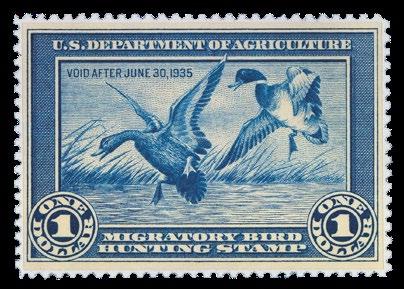
BOTTOM: The 73rd Federal Duck Stamp (2006-07) was designed by artist Sherrie Russell Meline. Used with permission from the U.S. Fish & Wildlife Service

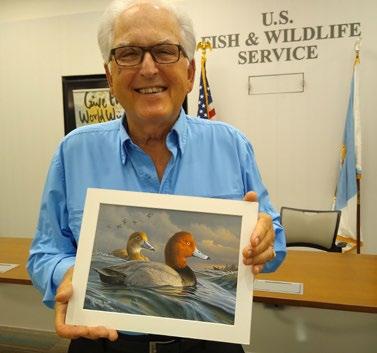
Clarksville-Montgomery County residents are fortunate to have the Tennessee National Wildlife Refuge complex less than an hour away. The Cross Creeks National Wildlife Refuge on Barkley Lake between Dover and Cumberland City is the closest, while other portions are located on Kentucky Lake and include the Big Sandy Unit in Henry County, Duck River Unit in Humphreys County and Busseltown Unit in Decatur County. A visitor center with interpretive wildlife exhibits and hiking trails is located in Springville, Tennessee, just outside of Paris.
Wildlife exhibits at the Customs House Museum & Cultural Center have covered everything from the waterfowl refuge at Reelfoot Lake to artwork by local and nationally renowned artists, such as bird artist Richard Sloan. This spring, the exhibit Society of Animal Artists: The Animals of North America is on view in Crouch Gallery from May 5 to June 26. Looking at the rivers, parks and wildlife of Middle Tennessee, the exhibit Tennessee Wild Side is on view in Orgain & Bruner Galleries from May 3 to June 22.

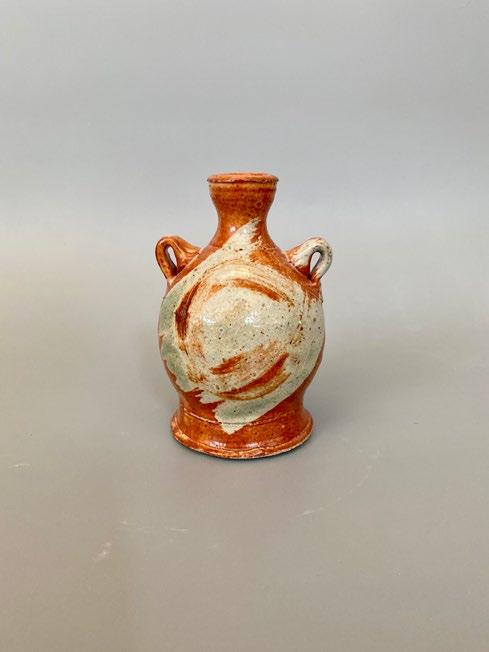
When not viewing wildlife and landscape scenes at the Museum, take your binoculars and enjoy our local wildlife and wild places.

cumberlandriverartist.com fws.gov/refuge/tennessee fws.gov/birds/get-involved/duck-stamp.php


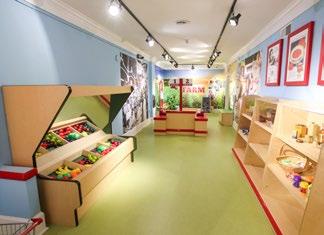
This January brought a new addition to the Museum’s slate of permanent exhibitions.
Explorers Landing has existed as a children’s gallery at the Customs House Museum & Cultural Center since the early 1990s, growing over time to include community favorites like the Bubble Cave and McGregor’s Market. While the space has evolved over the past three decades, it was time for a major revamp.


Starting in early 2020, the Museum embarked on an 18-month journey that has culminated in Exploring Our Town, a hands-on educational exhibit that fosters curiosity and tells the story of Clarksville. It was a collaborative effort from a diverse team of professionals, from within and outside of the Museum, to create this enduring installation that Museum visitors will enjoy for years to come.
This endeavor was set in motion in February 2020 with a call from the Downtown Kiwanis Club of Clarksville, which has been serving Montgomery County since 1920. Dan Black, Club President at the time, reached out to Executive Director Frank Lott and explained that the Kiwanis Club was looking to fund a project for children, asking if the Museum was planning any new installations. Lott replied that the children’s floor was in serious need of renovation, and after meetings with the club’s executive committee and board, the Museum received a financial commitment for the project.
In May 2021, the Museum also submitted a grant proposal to the Clarksville-Montgomery County Community Health Foundation, which supports projects designed to promote the general health of local residents. In addition to the exhibit encouraging healthy choices, Explorers Landing aims to facilitate free play for children of all ages, to the benefit of their mental and physical health. The Museum received a commitment of $150,000 from each of these title sponsors, making the renovation financially possible.
“The need led to an opportunity, which led to a commitment – that's how these success stories happen,” said Lott. “It’s a story about our community, funded within our community.”

The Museum retained exhibit designer Miriam Owen, whose designs can be seen at museums and businesses all over Tennessee and beyond. The Wade Bourne Nature Center at Rotary Park is an example of her recent work in Clarksville. For a project of this magnitude, an exhibit designer provides services similar to an architect, not only establishing the specifications of what needs to be built, but also determining the color palette, types of materials and a project timeline.
After an initial meeting in May 2020, Owen and the Museum team developed full-color conceptual illustrations and schematic drawings throughout the year. The Customs House building presented the unique challenge of designing in a space that is over 120 years old with extensive structural limitations. For Owen, the challenge is part of the creative process – the eccentricities of an older building mandated the flow of how everything would work together. By the beginning of 2021, the team finalized floorplans, elevations and the exhibit's overall storyline.
“In a children’s exhibit, I always strive to make it engaging for both children and parents,” said Owen. “It’s great to see how they can play and interact together. It's all about play.”
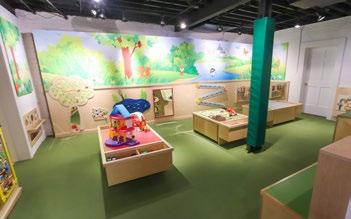
The rest of 2021 was spent finalizing text, images and design. The content development for this exhibit brought together all Museum departments, assembling a crew that included Executive Director Frank Lott, Curator of Education Sue Lewis, Curator of Collections Anna Woten, Content Editor Becky Wood, Board Member Larry Richardson, Exhibit Preparator Randy Spurgeon and consulting scientist Laurina Lyle, PhD. Together, the group crafted an exhibit that highlights the different elements that impacted the establishment and growth of Clarksville, such as geology, farming, architecture, transportation and the Cumberland River.
As the exhibit content was finalized, graphic designer Karen Lyle came on board to set the visual tone and turn those words and images into what is seen in Explorers Landing today. As a graphic artist, Lyle takes the specifications from the exhibit designer and the content developed by the Museum staff and interprets them artistically. Once she heard the tagline “An Adventure for All Ages,” she was inspired to create a badge similar to those given in a children's scouting program.
“Because the exhibit is titled Exploring Our Town, I created art that represents Clarksville – specifically the very
recognizable 1898 Museum building where this exhibit is housed,” explained Lyle. The result is colorful and inviting, bringing together the past, present and future to tell the story of what makes Clarksville the town it is today.


Exploring Our Town needed to be custom built by highlyskilled exhibit fabricators. In June 2021, the winning fabrication bid went to 1220 Exhibits, a Nashville firm. From the Pro Football Hall of Fame in Canton, Ohio to the National Civil Rights Museum in Memphis, 1220 Exhibits is a nationally recognized leader in the production and installation of exhibits. Their work is also on display at the Museum in Becoming Clarksville: Honoring Legacies of Leadership in Heritage Hall.

“I hope Museum visitors are inspired to explore all Clarksville has to offer, outside of the Museum as well.”
Karen Lyle, Graphic Designer
Explorers Landing was closed to the public at the end of November to begin the final phase of the renovation and installation process. The space was completely overhauled to make room for new wall graphics and engaging elements, like the new car ramp, light-up LED murals and other interactive components. For two months, 1220 collaborated with the Museum’s exhibits and facilities staff on every detail, down to the smallest finishing touches.
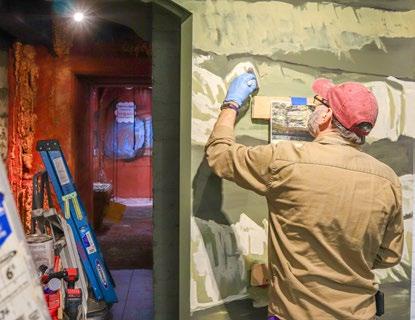
With 16 primary care and specialty providers located full time in the Clarksville area, Tennova Medical Group offers convenient, quality care for your family. From sore throats and fever to annual wellness visits and more specialized care, we’ve got you covered close to home.

To schedule an appointment or learn more about our locations and specialties, please visit ClarksvilleTennovaMedicalGroup.com or call 855-526-1755.
After an official ribbon cutting on January 28, 2022, Exploring Our Town opened to Museum members and the general public on Saturday, January 29. The Museum had over 600 visitors during the exhibit’s opening weekend, which was celebrated with extra giveaways and take-home activities for kids. It was an exciting and proud moment for everyone at the Museum, but particularly for Curator of Education Sue Lewis, who has seen Explorers Landing evolve since its very beginning over 30 years ago.
“
Exploring Our Town provides children with a physical opportunity to discover more about their town, learn of its past and recognize the workers who build and sustain it, while inspiring their own dreams of the future,” said Lewis. “It was the opening of McGregor’s Market in 2010 that gave me the idea of one day telling Clarksville’s story through history and science-based interactives. I'm grateful to everyone who came together on this project to make that dream a reality.”
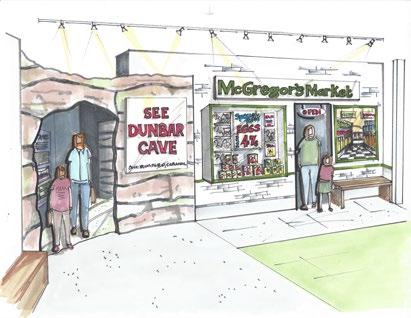
Explorers Landing is open Tuesday through Saturday, 10am to 4:30pm, and Sunday, 1pm to 4:30pm.
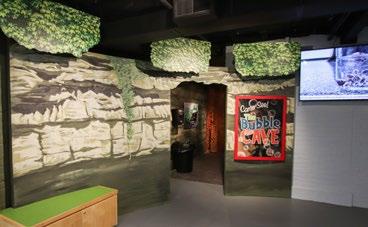
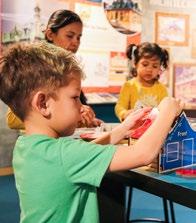

customshousemuseum.org/exhibits/explorers-landing

“No matter how long one has lived here or how old or young one may be, all will rediscover Clarksville in a way that will entertain, fascinate, educate and even inspire a greater appreciation for this marvelous community we call home.”
Frank Lott, Executive Director
There’s always something going on at the Museum. Share your visit with us! Tag us for a chance to be featured on our social media, in the Museum or right here in Second & Commerce.
